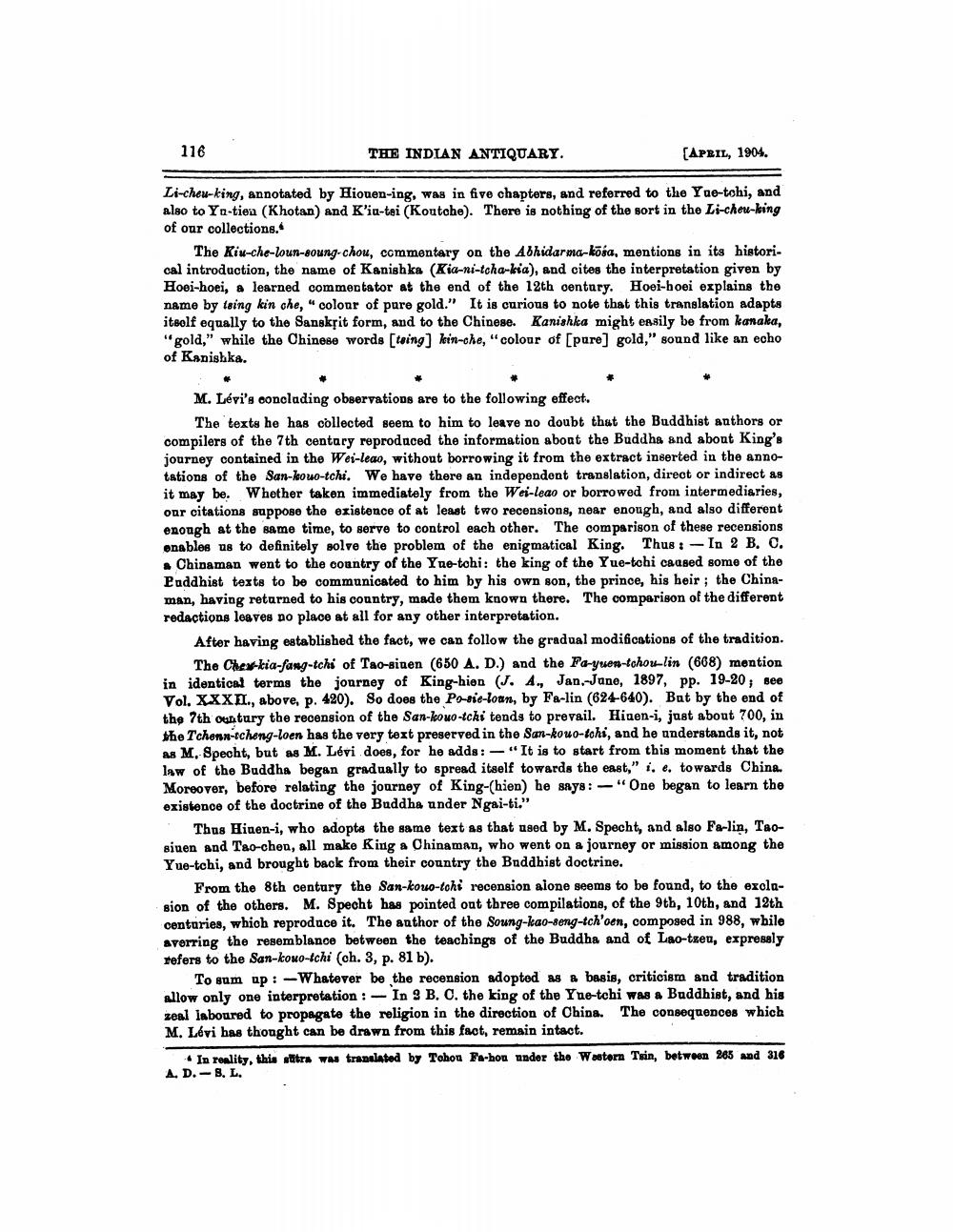________________
116
THE INDIAN ANTIQUARY.
[APRIL, 1904.
Li-cheu-king, annotated by Hiouen-ing, was in five chapters, and referred to the Yue-tohi, and also to Yu-tiea (Khotan) and K'iu-tei (Koutche). There is nothing of the sort in the Li-cheu-king of our collections.
The Kiu-che-loun-soung chou, commentary on the Abhidarma-kosa, mentions in its historical introduction, the name of Kanishka (Kia-ni-tcha-kia), and cites the interpretation given by Hoei-hoei, a learned commentator at the end of the 12th century. Hoei-hoei explains the name by tsing kin che, "colonr of pure gold.” It is curious to note that this translation adapts itself equally to the Sanskrit form, and to the Chinese. Kanishka might easily be from kanaka, "gold," while the Chinese words [tring] kein-che, "colour of (pure) gold," sound like an echo of Kanishka.
M. Lévi's conclading observations are to the following effect.
The texts he has collected seem to him to leave no doubt that the Buddhist anthors or compilers of the 7th century reprodaced the information about the Buddha and about King's journey contained in the Wei-leao, without borrowing it from the extract inserted in the annotations of the San-louo-tchi. We have there an independent translation, direct or indirect as it may be. Whether taken immediately from the Wei-leao or borrowed from intermediaries, onr citations suppose the existence of at least two recensions, near enough, and also different enough at the same time, to serve to control each other. The comparison of these recensions enables us to definitely solve the problem of the enigmatical King. Thus: - In 2 B. C.
Chinaman went to the country of the Yne-tohi: the king of the Yue-tchi caused some of the Paddhist texts to be communicated to him by his own son, the prince, his beir; the Chinaman, having returned to his country, made them known there. The comparison of the different redactions leaves no place at all for any other interpretation.
After having established the fact, we can follow the gradual modifications of the tradition.
The Chew-kia-fang-tchi of Tao-sinen (650 A. D.) and the Paynon-tchou-lin (668) montion in identical terms the journey of King-hien (J, A., Jan.-June, 1897, pp. 19-20, see Vol. XXXII., above, p. 420). So does the Po-sie-loan, by Fa-lin (624-640). Bat by the end of the 7th ountury the recension of the San-kowo-tcki tends to prevail. Hinen-i, just about 700, in the Tchonn-tcheng-loen has the very text preserved in the San-kowo-tchi, and he understands it, not as M, Specht, but as M. Lévi does, for he adds: - "It is to start from this moment that the law of the Buddha began gradually to spread itself towards the east," i, e, towards China. Moreover, before relating the journey of King-(hien) he says: - "One began to learn the existonoo of the doctrine of the Buddha under Ngai-ti."
Thus Hinen-i, who adopts the same text as that used by M. Specht, and also Fa-lin, Taosiuen and Tao-chen, all make King a Chinaman, who went on a journey or mission among the Yue-tchi, and brought back from their country the Buddhist doctrine.
From the 8th century the San-kowo-tchi recension alone seems to be found, to the exolasion of the others. M. Specht has pointed out three compilations, of the 9th, 10th, and 12th centuries, which reproduce it. The author of the Soung-kao-seng-ch'oen, composed in 988, while averring the resemblance between the teachings of the Buddha and of Lao-tzen, expressly refers to the San-koro-Ichi (ch. 3, p. 81 b).
To sum ap: -Whatever be the recension adopted as a basis, criticism and tradition allow only one interpretation :- In 3 B. O. the king of the Yue-tehi was a Buddhist, and his zeal laboured to propagate the religion in the direction of China. The consequences which M. Lévi has thought can be drawn from this fact, remain intact.
In reality, this sitra was translated by Tehoa Fa-hon under the Wostorn Tsin, between 265 and 316 A. D.-S.L.




